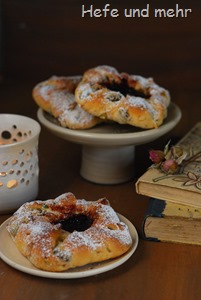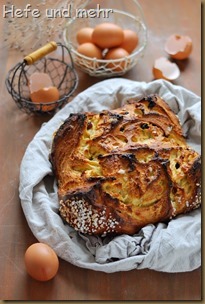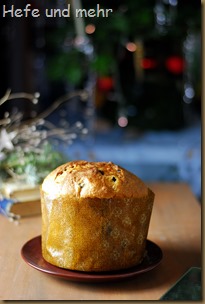 Last year I saw a Christstollen with Sourdough which “Ofenkante” published on his blog. This stirred my brain and I started to think about Stollen made with sweet starter. But as I was already done with Stollen baking at this time point, I stored the idea in the back of my mind. After one year of thinking about it I decided to bake directly two stollen for this Christmas: a traditional and a experimental one.
Last year I saw a Christstollen with Sourdough which “Ofenkante” published on his blog. This stirred my brain and I started to think about Stollen made with sweet starter. But as I was already done with Stollen baking at this time point, I stored the idea in the back of my mind. After one year of thinking about it I decided to bake directly two stollen for this Christmas: a traditional and a experimental one.
In the experimental stollen with sweet starter I kept the same ratio of ingredients then in my traditional one (never change a winning team) but build the the sweet starter over several steps to get a enough strength for rising. It is always amazing to see how strong the sweet starter gets when fed three times in a row! But as the feeding is time consuming, this recipe needs a day until it is done.
After four weeks of ripening I brought the stollen from the cold attic back to the warm kitchen and sliced it. The crumb was perfect, firm but moist and the different flavours had fused to a harmonic consonance. Compared to the traditional stollen there are subtle differences in flavour nuances, but it is hard to pin them down. After all, both of them taste terrific and I can not name a favourite.

 I can not tell how I learn about the Reformationsbrötchen (reformation rolls). But the idea somehow stuck in mind and so I had to bake them just in time for the 31. October (Reformation day).
I can not tell how I learn about the Reformationsbrötchen (reformation rolls). But the idea somehow stuck in mind and so I had to bake them just in time for the 31. October (Reformation day).
 Last weekeend I realized how near Eastern is when my mom told me on the phone about her plans of dyeing eggs with her kids at school. And so I changed my plans for the bread baking course and developed a sweet recipe perfect for the Easter Breakfast. It is a sweet bread called which is made with the biga preferement. The subtle acidity of it helps to strengthen the gluten network. For a tender crumb the dough contains cream, egg yolk and some butter. By replacing the butter with cream the dough can rise in the fridge if needed.
Last weekeend I realized how near Eastern is when my mom told me on the phone about her plans of dyeing eggs with her kids at school. And so I changed my plans for the bread baking course and developed a sweet recipe perfect for the Easter Breakfast. It is a sweet bread called which is made with the biga preferement. The subtle acidity of it helps to strengthen the gluten network. For a tender crumb the dough contains cream, egg yolk and some butter. By replacing the butter with cream the dough can rise in the fridge if needed.
 At five o’clock the next morning, on my way to the bathroom, I quickly checked the Panettone in the kitchen. And turned the oven on. Ten hours were what they needed to reach the rim of the form. And who needs sleep?
At five o’clock the next morning, on my way to the bathroom, I quickly checked the Panettone in the kitchen. And turned the oven on. Ten hours were what they needed to reach the rim of the form. And who needs sleep?



 I planned to bake “Kletzenbrot” this year. Kletzenbrot is named after the Kletzen which are added to the dough and this Kletzen are dried pears. But then I remembered that I have to big glasses filled with dried apples in the pantry because this autumn I dried a lot of the apples we harvest. (I mentioned before that we harvest lots and lots of apples this year, didn’t I?)
I planned to bake “Kletzenbrot” this year. Kletzenbrot is named after the Kletzen which are added to the dough and this Kletzen are dried pears. But then I remembered that I have to big glasses filled with dried apples in the pantry because this autumn I dried a lot of the apples we harvest. (I mentioned before that we harvest lots and lots of apples this year, didn’t I?)